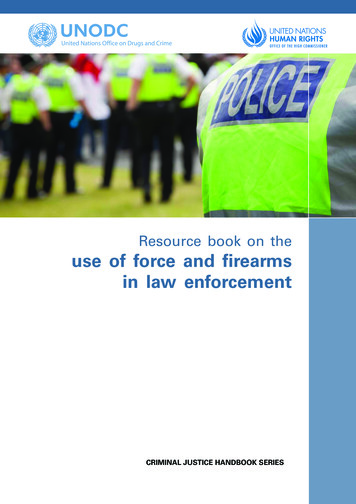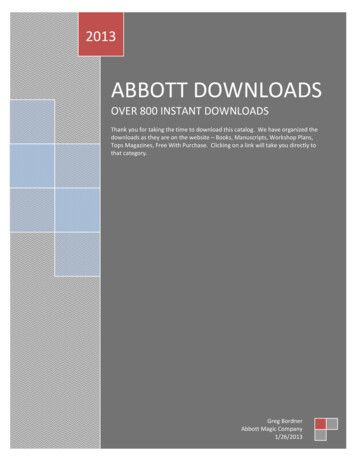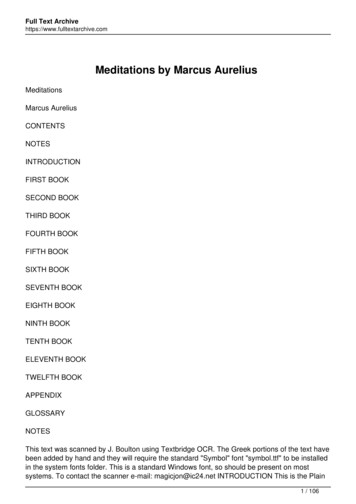
Transcription
Resource book on theuse of force and firearmsin law enforcementCRIMINAL JUSTICE HANDBOOK SERIES
OFFICE OF THE UNITED NATIONS HIGH COMMISSIONER FOR HUMAN RIGHTSUNITED NATIONS OFFICE ON DRUGS AND CRIMEResource book on the use of forceand firearms in law enforcementUNITED NATIONSNew York, 2017
2017 United NationsThis work is available open access by complying with the Creative Commons licence created forinter-governmental organizations, available at lishers must remove the original emblems from their edition and create a new cover design.Translations must bear the following disclaimer: “The present work is an unofficial translationfor which the publisher accepts full responsibility.” Publishers should e-mail the file of theiredition to publications@un.org.Photocopies and reproductions of excerpts are allowed with proper credits.United Nations publication issued by the United Nations Office on Drugs and Crime (UNODC)and the Office of the United Nations High Commissioner for Human Rights (OHCHR).HR/PUB/17/6 (OHCHR)Cover photograph: iStock/kelvinjayPublishing production: English, Publishing and Library Section, United Nations Office at Vienna.This publication has not been formally edited.The description and classification of countries and territories in this publication and thearrangement of the material do not imply the expression of any opinion whatsoever on the partof the Secretariat of the United Nations concerning the legal status of any country, territory,city or area, or of its authorities, or concerning the delimitation of its frontiers or boundaries, orregarding its economic system or degree of development.
AcknowledgementsThe resource book is the result of a joint effort by the United Nations Office on Drugs andCrime (UNODC) and the Office of the United Nations High Commissioner for Human Rights(OHCHR), with the financial and substantive support of the Swiss Ministry of Foreign Affairsand the financial support of the Ministry of Foreign Affairs of Norway. The publication benefitedfrom information gathered at an expert meeting held in Vienna in May 2015, as well as throughtwo regional expert meetings organized by the Geneva Academy of International HumanitarianLaw and Human Rights and UNODC, respectively in Buenos Aires, from 8 to 9 May 2014 andTunis, from 26 to 28 January 2015.The contributions received from the following experts are hereby acknowledged with appreciation:Otto Adang, Netherlands Police Academy; Stuart Casey-Maslen, Consultant to ProfessorChristof Heyns, University of Pretoria and former United Nations Special Rapporteur on extrajudicial, summary or arbitrary executions; Neil Corney, Omega Research Foundation; MilenaCostas Trascasas, Consultant; Omer Fisher, OSCE Office for Democratic Institutions andHuman Rights (ODHIR); Chris Graveson, Consultant; Robert Grinstead, Consultant; Hilarius(Lars) Huybrechts, International Committee of the Red Cross (ICRC); Neil Jarman, Institutefor the Study of Conflict Transformation and Social Justice, Queen’s University Belfast; Chair,OSCE Panel of Experts on Freedom of Peaceful Assembly; Tim Mairs, Police Service ofNorthern Irland (PSNI); Simon Martin, Consultant, former police officer (UnitedKingdom); Miriam Minder, Swiss Government; Ruth Montgomery, Consultant; JacobPunnoose, India National Police; David Rosset, Office of the Police Commissioner, UnitedNations Mission in South Sudan; Matthew Sands, Legal adviser, Association for thePrevention of Torture; Olafimihan Adeoye, Deputy Commissioner of Police (DCP)Operations, Nigerian Police Force, Awka-Anambra State HQ; Ignacio Cano, CoordinatorLaboratory for the Analysis of Violence, State University Rio de Janeiro; Maja Daruwala,Commonwealth Human Rights Initiative (CHRI), New Delhi; Uladzimir Dzenisevich,Commonwealth Human Rights Initiative (CHRI), New Delhi; Hugo Frühling, University ofChile; Roger Gaspar, Consultant, former police officer (United Kingdom); Rachel Neild, OpenSociety Justice Initiative (OSJI); Vivienne O’Connor, United States Institute of Peace (USIP);Ralph Price, Chicago Police Department; Darius Rejali, Reeds University; Colin Roberts,Universities Police Science Institute, former police officer (United Kingdom); Ralph Roche,Human Rights Advisor, Police Service of Northern Island (PSNI); Josiane SomdataTapsoba, Legal Officer, African Commission on Human and Peoples’ Rights (ACHPR)Secretariat, African Union Commission (AUC), and the International Network to Promotethe Rule of Law (INPROL).iii
Special thanks and acknowledgement to Christof Heyns, former United Nations SpecialRapporteur on extrajudicial, summary or arbitrary executions; Maina Kiai, former SpecialRapporteur on the freedoms of peaceful assembly and of association; Manfred Nowak, formerSpecial Rapporteur on torture and other cruel, inhuman or degrading treatment or punishment,and Eleanor Jenkins and Kathleen Hardy, consultants to the Special Rapporteurs.UNODC wishes to acknowledge the substantive contribution of Anneke Osse, as consultant.Contributing throughout the development of the resource book were UNODC staff Anna Giudice,Claudia Baroni, Johannes (Joop) de Haan, Mohamed Hassani, Philip Meissner, Piera Barzano,Simon Charters, Simone Heri, Ulrich Garms and Valerie Lebaux, with the support of UNODCinterns Viviane Damoiseaux, Rouzbeh Mouradi and Rohan Sinha. Further contributions camefrom Julien Chable, Hilarius (Lars) Huybrechts, Neil Davison (ICRC) and Mehdi Benchelah(UNESCO). On behalf of OHCHR, colleagues from the Rule of Law and Democracy Sectionwere the main contributors.**The policy of OHCHR is not to attribute authorship of publications to individuals.
ContentsAcknowledgementsiiiList of standards cited and acronyms usedviiIntroduction1Key concepts and actors1PART I. SETTING THE BOUNDARIES FOR THE USE OF FORCE IN LAW ENFORCEMENT1.The international legal framework for use of force in law enforcement61.1. International human rights law, United Nations Standards and Norms on Crime Prevention andCriminal Justice and the use of force61.2. From international law to day-to-day instructions81.3. Key human rights standards related to use of force111.4. Rights and obligations: respect, protect, fulfil151.5. The obligations in practice: guiding principles for use of force in law enforcement161.6. Use of firearms202.Human rights-based approach to law enforcement: legitimacy,non-discrimination and accountability242.1. Legitimacy: law enforcement by consent rather than force242.2. Non-discrimination: providing fair law enforcement for all282.3. Scrutiny36PART II. THE RESPONSIBILITY OF LAW ENFORCEMENT AUTHORITIES3.PART III.5Command and control41423.1. The role of governments and law enforcement agencies in creatingthe conditions necessary for professional law enforcement423.2. An effective line of command433.3. Orders and obedience453.4. Planning for operations473.5. Creating a culture of professionalism and respect for human rights504.Human resources management534.1. Recruitment, selection and promotion534.2. Training544.3. Performance management584.4. Early intervention systems60INSTRUMENTS OF FORCE635.64A “range of means” to allow for a differentiated response5.1. Introduction: apply non-violent means first645.2. A range of means645.3. Instruments of “less-lethal” force665.4. How to decide when to use what type of force?685.5. Use-of-force models and matrices715.6. Protective gear, communication equipment and self-defence735.7. Procuring instruments of force74v
6.PART IV.PART V.Guidance for the most commonly used instruments of forcein law enforcement786.1. General principles for all instruments786.2. Instruments of force806.3. Control, storage, registration and issuance of instruments of force100POLICING SITUATIONS1057.106Public assemblies and protests7.1. Introduction1067.2. Taking precaution: preventing the use of force1097.3. Use of force during assemblies1167.4. Allowing monitors and journalists1247.5. Accountability after the event1258.128Criminal investigation8.1. Introduction1288.2. Criminal investigation methods1288.3. The suspect interview1308.4. Measures to prevent coercion, ill-treatment and torture during a suspect interview1329.135Stop and search, arrest and detention9.1. Stop and search1359.2. Arrest1369.3. Use of force in detention143ACCOUNTABILITY FOR THE USE OF FORCE AND FIREARMS INLAW ENFORCEMENT15110. Reporting, monitoring and review15210.1. Introduction15210.2. Collecting information: reporting afterwards and recording in “real time”15310.3. Collecting and analysing the data15711.159Complaints and investigations11.1. Introduction15911.2. Receiving and handling complaints16011.3. Investigations into (alleged) arbitrary or excessive use of force16211.4. Remedy17012. Independent oversight bodies17212.1. Introduction17212.2. Setting up an independent external body17312.3. Oversight over detention facilities17712.4. Report findings179References180vi
List of standards cited and acronyms usedACPOAssociation of Chief Police OfficersAEPAttenuating Energy ProjectilesAPPAuthorized Professional PracticeBasic PrinciplesBasic Principles on the Use of Force and Firearms by Law EnforcementOfficials (BPUFF)Body of PrinciplesBody of Principles for the Protection of All Persons UnderAny Form of Detention or ImprisonmentBPUFFBasic Principles on the Use of Force and Firearms by Law EnforcementOfficialsCATConvention against Torture and Other Cruel, Inhuman or DegradingTreatment or PunishmentDPKODepartment of Peacekeeping OperationsECHREuropean Court of Human RightsEJEExtrajudicial, Summary or Arbitrary Execution(s)FOAAFreedom of Peaceful Assembly and of AssociationHRCHuman Rights CommitteeIACPInternational Association of Chiefs of PoliceICCPRInternational Covenant on Civil and Political RightsICPAPEDInternational Convention for the Protection of All Persons from EnforcedDisappearanceICRCInternational Committee of the Red CrossINPIndonesian National PoliceIPIDIndependent Police Investigative Directorate (South Africa)LEALaw Enforcement Agency(ies)LEOLaw Enforcement Official(s)LGBTILesbian, Gay, Bisexual, Transsexual and IntersexNelson Mandela RulesRevised United Nations Standard Minimum Rules for the Treatment ofPrisoners (SMR Revised)NGONon-Governmental OrganizationNPMNational Prevention MechanismOHCHROffice of the United Nations High Commissioner for Human RightsOPCATOptional Protocol to the Convention Against TortureOSCEOrganization for Security and Co-operation in EuropePLANProportionality, Legality, Accountability and NecessityPSNIPolice Service of Northern IrelandRCMPRoyal Canadian Mounted PoliceSAPSSouth African Police ServiceSMRUnited Nations Standard Minimum Rules for the Treatment of PrisonersSOPStandard Operational/Operating Procedure(s)SRSpecial RapporteurSWATSpecial Weapons and TacticsUDHRUniversal Declaration of Human RightsUN Code of ConductUnited Nations Code of Conduct for Law Enforcement OfficialsUNESCOUnited Nations Organization for Education, Science and CultureUNODCUnited Nations Office on Drugs and CrimeHavana RulesUnited Nations Rules for the Protection of Juveniles Deprived of their Libertyvii
IntroductionThis resource book relates to the use of force and firearms by law enforcement officials. Lawenforcement officials’ power to use force derives from the duty of the State to maintain publicorder, to protect persons within its jurisdiction, and ensure human rights and the rule of law.While the use of force may be lawful and necessary in certain cases, it can result in damage toproperty, injury, loss of life and may interfere with or violate human rights. Law enforcementofficials have the authority to use force in situations where it is necessary in order to achieve alegitimate law enforcement objective. Force may, for example, be used to ensure compliancewith lawful police instructions, to arrest non-cooperative or dangerous suspects, protect members of the general public or break up a violent crowd. However, such use of force should alwaysrespect a State’s obligations under international law, which include conditions imposed by international human rights law, included in treaties or recognized as customary international law. TheUnited Nations standards and norms on crime prevention and criminal justice, developed andadopted through consensus by the governing bodies of UNODC (the Crime Congress, theCommission on Crime Prevention and Criminal Justice, the United Nations Economic andSocial Council and the General Assembly) through an intergovernmental process, provide animportant benchmark for measuring the functioning of the criminal justice system, includinglaw enforcement agencies.In order to prevent the abusive use of force and violation of human rights in law enforcement,States should establish a carefully elaborated legal and policy framework, along with the adequateguidance and training that reflects the State’s legal obligations, both domestic and international.Any use of force by law enforcement officials must be strictly compliant with that framework.This resource book explores international law sources relevant to the use of force and thegeneral responsibility of law enforcement authorities for the use of force. It discusses a numberof instruments of force, including firearms, and the conditions under which these should beused. It further examines the possible use of force in a number of specific policing situations.Finally, it also outlines good practices for accountability in the use of force and firearms by lawenforcement officials.Key concepts and actorsUse of forceIn this resource book, “use of force” refers to the use of physical means that may harm aperson or cause damage to property.1 Physical means include the use of hands and body bylaw enforcement officials; the use of any instruments, weapons or equipment, such as batons;chemical irritants such as pepper spray; restraints such as handcuffs; dogs; and firearms. Theactual use of force has the potential to inflict harm, cause (serious) injury, and may be lethalin some instances.1In a 2001 study the International Association of Chiefs of Police (IACP) defined “use of force” as “the amountof effort required by police to compel compliance by an unwilling subject.” For more information on the definitionof “use of force”, visit IACP Police Use of Force in America (United States, 2001): /2001useofforce.pdf.1
2Resource book on the use of force and firearms in law enforcementIn accordance with international law, force should only be used to the extent it is necessary2 toachieve a legitimate law enforcement objective and be applied in accordance with domesticlaws, regulations and training that, in turn, are compliant with relevant international obligations.Where this is not the case and the force applied is excessive or arbitrary, it is by definition alsounlawful. In the case of allegations of unlawful or arbitrary use of force, there should beaccountability mechanisms in place.FirearmsThere is no internationally agreed definition of the term “firearm”, and the Basic Principleson the Use of Force and Firearms by Law Enforcement Officials does not provide a definition. In the Protocol Against the Illicit Manufacturing of and Trafficking in Firearms, theirParts and Components and Ammunition, supplementing the United Nations Conventionagainst Transnational Organized Crime, 2001, firearm refers to “any portable barrelled weaponthat expels, is designed to expel or may be readily converted to expel a shot, bullet or projectileby the action of an explosive, excluding antique firearms or their replicas”,3 and this resourcebook uses this definition as a reference. The different types of firearms relevant for thisresource book are further explored in chapter 6.Unlawful, excessive or arbitrary use of forceUnlawful use of force means force that violates the principle of legality, i.e. force that has aninsufficient legal basis or that is used in pursuance of an objective that cannot be qualified as alegitimate law enforcement objective. Such legitimacy is determined by domestic law, whichshould be compliant with international human rights obligations. Excessive use of force appliesto situations where the use of force was legal and legitimate, but the type and level of force wasunnecessary and/or disproportionate. Use of force is arbitrary when resorting to force (or thespecific type and level of force), is not legitimate in light of the specific circumstances, and presents an element of injustice, discrimination, unreasonableness, abuse of power, or exercise ofunwarranted discretion. Arbitrary use of force may be both unlawful and/or excessive.Law enforcement officialThe United Nations Code of Conduct for Law Enforcement Officials4 defines the term“law enforcement official” as:“All officers of the law, whether appointed or elected, who exercise police powers,especially the powers of arrest or detention. In countries where police powers are exercised by military authorities, whether uniformed or not, or by State security forces, thedefinition of law enforcement officials shall be regarded as including officers of suchservices”.5For more on the concept of necessity as well as other standards see chapter 1, 1.5.The Protocol against the Illicit Manufacturing of and Trafficking in Firearms, their Parts and Componentsand Ammunition, which supplements the United Nations Convention against Transnational Organized Crime, wasadopted by General Assembly resolution 55/255 of 31 May 2001.4Code of Conduct for Law Enforcement Officials, adopted by General Assembly resolution 34/169 of17 December 1979, available from: /LawEnforcementOfficials.aspx5See Commentary to article 1 of the United Nations Code of Conduct for Law Enforcement Officials(GA/RES/34/169).23
INTRODUCTION The Guidelines for the Effective Implementation of the Code of Conduct for Law EnforcementOfficials state that the “definition of law enforcement officials shall be given the widest possibleinterpretation”.6 This resource book adopts the definition set out in the above-mentioned instruments. However, for purposes of readability, it also uses the term “police” synonymously to “lawenforcement officials”. Both terms are meant to cover all personnel involved in law enforcement,from border guards to immigration officials, if those officials are empowered to enforce laws.Whenever members of military forces execute functions of law enforcement, they should complywith the same international human rights laws as law enforcement officials, in addition to theirresponsibilities under international humanitarian law, where it is applicable. States should alsoensure their laws address the use of force by private security providers, who are engaged by theauthorities to carry out law enforcement functions, and hold them equally accountable.7Objectives of this resource bookOver the past decades, a number of international standards on the use of force in law enforcement have been developed. The two most commonly cited instruments are the 1979 UnitedNations Code of Conduct for Law Enforcement Officials (United Nations Code of Conduct)and the 1990 Basic Principles on the Use of Force and Firearms for Law Enforcement Officials(BPUFF).8 The United Nations Code of Conduct and the Basic Principles both provide guidance to States on the use of force by any law enforcement official, including, but not limited to,the police. This resource book aims to provide further guidance to States on how to implementthese standards and translate these instruments into law, policy and practice, and also in thelight of standards set by international human rights law.9This resource book focuses on four aspects of the use of force: How to use force in conformity with applicable United Nations standards and normsand international human rights law What can be done to reduce the need to resort to force How the abuse of force can be prevented What measures should be taken when unlawful, excessive or arbitrary use of force occursThe resource book restricts itself to examining issues related to the use of force and firearms inthe context of law enforcement operations and does not address the use of force that occurs inthe conduct of hostilities.10This resource book offers technical guidance for drafting domestic laws, policies on the use offorce and firearms in law enforcement, as well as accompanying sample regulations and standardoperating procedures (hereafter “SOPs”), which can then be translated into training and usedwhen drafting tactical plans for specific operations and daily instructions. It draws upon theSee E/RES/1989/61 at: https://www.unodc.org/pdf/compendium/compendium 2006 part 04 01.pdfSee UNODC Introductory Handbook on State Regulation concerning Civilian Private Security Services and TheirContribution to Crime Prevention and Community Safety, 2014, p. 44.8The Basic Principles were adopted by the eighth United Nations Congress on the Prevention of Crime andthe Treatment of Offenders, 1990; and reaffirmed by the GA (A/RES/45/166) during the sixty-ninth plenary meetingon 18 December 1990.9See Guidelines for the Effective Implementation of the Code of Conduct for Law Enforcement Officials,Guideline IB(1): Governments shall also promote education and training through a fruitful exchange of ideas at theregional and interregional levels.10For more on this, see for example ICRC, Expert Meeting – The use of force in armed conflicts, Interplaybetween the conduct of hostilities and law enforcement paradigm, 2013, available from: /icrc-002-4171.pdf673
4Resource book on the use of force and firearms in law enforcementwidely applied and recognized United Nations Standards and Norms on Crime Prevention andCriminal Justice and examples of national laws, regulations and practices from around the world.It has to be noted, however, that the country examples referenced in this resource book areillustrative and their use in this resource book does not imply that these laws, regulations orpractices are endorsed by the United Nations or considered best practice. Nor does this resourcebook suggest the adoption of these examples in other States without any further reflection asefficient laws and policies need to be adapted to the context in which they are to operate, havingdue regard to the political, social, economic climate, the security situation in the country, thelegal traditions, etc. Moreover, no matter how good the legal or policy framework, their impactdepends on the will and resources to implement them, with due respect for human rights andthe rule of law.Target group of this resource bookThis publication is offered as a tool to support States in their efforts to develop moreeffective and human rights-based law enforcement. The target group for this resource bookare policymakers, legal drafters, and staff at relevant government ministries, law enforcementagencies and training colleges responsible for drafting policies, regulations, SOPs and trainingmanuals on the use of force and firearms, and for stakeholders exercising control andoversight functions over law enforcement agencies. It is also a useful tool for managersacross the different command levels. In addition, it is a tool for bilateral and multilateralagencies and non-governmental organizations providing support to law enforcement reformand training initiatives.
PART ISETTING THE BOUNDARIESFOR THE USE OF FORCEIN LAW ENFORCEMENT
6Resource book on the use of force and firearms in law enforcementChapter 1. The international legalframework for use offorce in law enforcementThe Basic Principles of the Use of Force and Firearms (BPUFF) reflect the basic standard thatlaw enforcement officials should in carrying out their duty, as far as possible, apply non-violentmeans before resorting to the use of force and firearms. They define a set of parameters withinwhich law enforcement officials may use force and firearms when carrying out their functions,and prohibit the use of force that does not comply with these parameters and which therefore isunlawful, arbitrary or excessive.11This chapter identifies the key human rights obligations and commitments applicable to the useof force in law enforcement, and how these are translated into guiding principles for law enforcement practice. All human beings are entitled to respect for their human rights and fundamentalfreedoms, including the right to life and to security of their person, and to be free from tortureand other cruel, inhuman or degrading treatment or punishment.12 These rights and freedomsneed to be guaranteed in domestic laws, policy and practice. Guaranteeing respect and protection of human rights requires that States set up adequate rules and procedures governing whether,when, and in what manner the State is entitled to use force for law enforcement purposes.1.1. International human rights law, United Nations Standardsand Norms on Crime Prevention and Criminal Justice andthe use of forceInternational human rights law is a body of law designed to regulate the relationship betweenStates and individuals within their jurisdiction by setting out the rights individuals are entitledto, and the corresponding obligations of the State and other actors. By becoming parties to11See the BPUFF and the Report of the Special Rapporteur on extrajudicial, summary or arbitrary executions(E/CN.4/2006/53), 8 March 2006, para. 48: “Human rights law unconditionally prohibits the needless killing ofsuspected criminals, but it fully recognizes that lethal force is sometimes strictly necessary to save the lives of innocentpeople from lawless violence.”12Key international instruments include the Universal Declaration of Human Rights; the International Covenanton Civil and Political Rights; and the Convention against Torture and Other Cruel, Inhuman or Degrading Treatmentor Punishment. Regional instruments include: European Convention on Human Rights; American Convention onHuman Rights; African Charter on Human and Peoples’ Rights; Arab Charter of Human Rights; Inter-AmericanConvention to Prevent and Punish Torture; European Convention for the Prevention of Torture and Inhuman orDegrading Treatment or Punishment.
PART I.SETTING THE BOUNDARIES FOR THE USE OF FORCE IN LAW ENFORCEMENTinternational treaties, States assume obligations to respect, to protect and to fulfil human rights.13In addition to their obligations deriving from international treaties, States are also bound bythose international human rights standards that have the status of customary international law.Other international instruments also provide important guidance on the use of force and firearms. The two most important are the United Nations Code of Conduct for Law EnforcementOfficials (United Nations Code of Conduct) and the Basic Principles on the Use of Force andFirearms for Law Enforcement Officials (Basic Principles/BPUFF).14 Those internationaldeclarations, guidelines and principles, although not legally binding, can contribute to theunderstanding, implementation and development of international human rights law.The United Nations Code of Conduct, adopted by the General Assembly in 1979, states inarticle 3 that law enforcement officials may use force only when strictly necessary and to theextent required for the performance of their duty. The Basic Principles were adopted at theEighth United Nations Congress on the Prevention of Crime and the Treatment of Offenders in1990 and, on 18 December 1990, the United Nations General Assembly adopted resolution45/166, welcoming the Basic Principles and inviting States to “respect them and to take theminto account within the framework of their national legislation and practice”. The Basic Principles set out the core parameters to determine the lawfulness of use of force by law enforcementpersonnel and establish standards for accountability and review.These instruments, and in particular their provisions on the use of force as they relate to theright to life and physical integrity in particular—article 3 of the Code of Conduct and principle9 of the Basic Principles—are relied upon as authoritative by regional and national courts.15, 16In addition to the international instruments developed under the aegis of the United Nations,a range of instruments has been developed at the regional level, including binding andnon-binding instruments.13See, for example, United Nations Human Rights Committee General Comment No. 31 [80], The Nature ofthe General Legal Obligation Imposed on States Parties to the Covenant, CCPR/C/21/Rev.1/Add. 13.14Other relevant standards include the Body of Principles for the Protection of All Persons under Any Formof Detention or Imprisonment; Declaration of Basic Principles of Justice for Victims of Crime and Abuse of Power;Declaration on the Protection of All Persons from Enforced Disappearance; Principles on the Effective Preventionand Investigation of Extra-legal, Arbitrary and Summary Executions; United Nations Standard Minimum Rules forthe Administration of Juvenile Justice (“The Beijing Rules”); United Nations Rules for the Protection of JuvenilesDeprived of their Liberty (“Havana Rules”); United Nations Model Strategies and Practical Measures on the Elimination of Violence against Women in the Field of Crime Prevention and Criminal Justice; Istanbul Protocol; Declaration on the Rights of Indigenous Peoples; United Nations Model Strategies and Practical Measures on theElimination of Violence against Children in the Field of Crime Prevention and Criminal Justice; Revised UnitedNations Standard Minimum Rules for the Treatment of Prisoners (SMR Revised or Nelson Mandela Rules); UnitedNations Principles and Guidelines on Access to Legal Aid in Criminal Justice Systems. For more information
The resource book is the result of a joint effort by the United Nations Office on Drugs and Crime (UNODC) and the Office of the United Nations High Commissioner for Human Rights (OHCHR), with the financial and substantive support of the Swiss Ministry of Foreign Affairs and the financial support o f the Ministry of Foreign Affairs of Norwa y.











